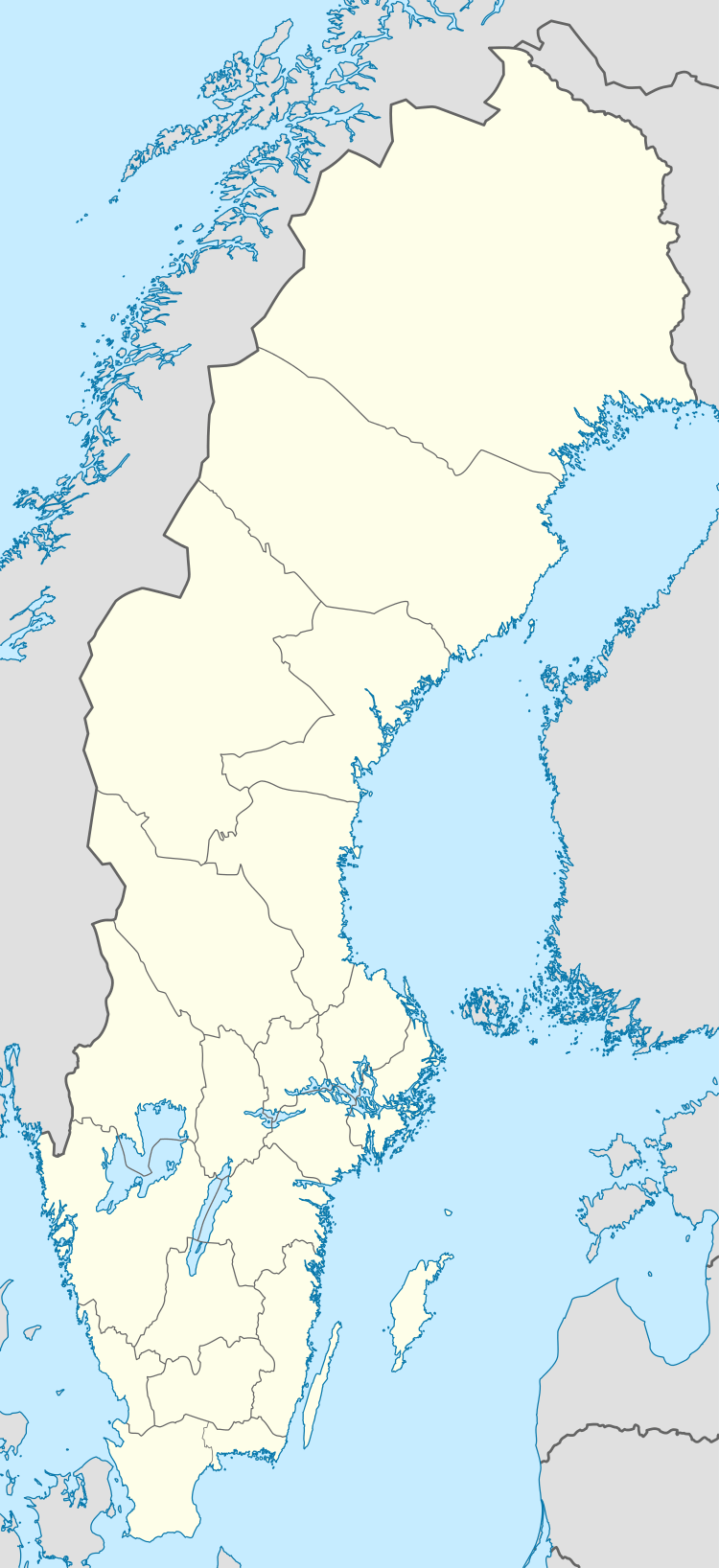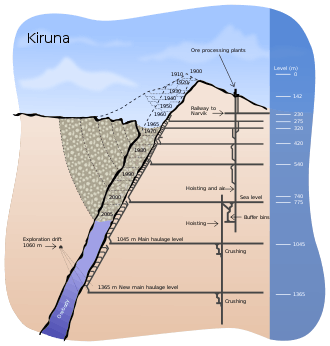Kiruna Mine
The Kiruna mine is the largest and most modern underground iron ore mine in the world.[1] The mine is located in Kiruna in Norrbotten County, Lapland, Sweden.[1] The mine is owned by Luossavaara-Kiirunavaara AB (LKAB), a large Swedish mining company. In 2018 the mine produced 26.9 million tonnes of iron ore.[2] The Kiruna mine has an ore body which is 4 km (2.5 mi) long, 80 metres (260 ft) to 120 metres (390 ft) thick and reaching a depth of up to 2 km (1.2 mi). Since mining began at the site in 1898, the mine has produced over 950 million tonnes of ore.[1]
 Kiruna Mine and townsite from ISS, 2016 | |
| Location | |
|---|---|
 Kiruna mine Location in Sweden | |
| Location | Kiruna |
| Municipality | Lapland |
| Country | Sweden |
| Coordinates | 67°51′01″N 020°11′34″E |
| Production | |
| Products | Iron ore |
| Production | 26.9 million tonnes |
| Financial year | 2018 |
| History | |
| Opened | 1898 |
| Owner | |
| Company | Luossavaara-Kiirunavaara AB |
In 2004, it was decided that the present centre of the city would need to be relocated to accommodate mining-related subsidence. The relocation would be made gradually over decades.[3]
On May 18, 2020 an earthquake of approximate 4.9 Mw was triggered in the footwall of the mine.[4] The earthquake was not natural but induced by the mining activity.[4]
History
.jpg)
The Kiruna mineral deposit was formed following intense volcanic activity. Iron-rich solutions precipitated the iron on to a syenite porphyry footwall.[5] Then the ore bed was covered by further volcanic deposits, quartz porphyry, and sedimentary rocks. Later the whole body was tilted to its current dip of 50 to 60°. The ore is predominately magnetite and disseminated interstitial apatite, with an average of 0.9% phosphorus.[5][6]
In 1902 the Kiruna Narvik Railway was completed, allowing the shipment of ore through the ice-free port of Narvik.[7]
In the beginning, surface mining was used, but the mine has been mined with the sublevel caving mining method since the 1960s. In 1985 reserves for the Kiruna Mine were 1,800 million tonnes grading 60–65% iron and 0.2% phosphorus.[8][1] As of 2018 the Kiruna Mine had Proven and Probable Reserves of 683 million tonnes grading 43.8% iron.[9]
Until 1999 the deepest level of the mine reached 775 metres (2,543 ft), but after 1999 mining went deeper, reaching a depth of 1,045 metres (3,428 ft).[1] The 1,045 metres (3,428 ft) level could support iron ore production until 2018. On October 28, 2008 LKAB decided to go even deeper, with the mine reaching a depth of 1,365 metres (4,478 ft) by 2012 at a cost of US$1.7 billion.[1]

Moving the town
The re-development of Kiruna is a reconstruction project, as the Kirunavaara mine, run by LKAB, undermines the current town centre. The town centre is to be moved 3 km (1.9 mi) to the east. 21 of the most important buildings are to be moved.[10]
In 2004, it was decided that the city centre would need to be relocated to accommodate mining-related subsidence. The relocation would be made gradually over the coming decade. In January 2007 a new location was proposed, to the northwest at the foot of Luossavaara mountain, by Lake Luossajärvi.[11]
The first physical work moving the town commenced in November 2007, when work on the new main sewerage pipe started.[12]
In the same week, first sketches for the layout of the new part of the town became available.[13] The sketches include a travel centre, the new locations for the city hall and the church, an artificial lake and an extension of the Luossavaara hill into the city.[14] The location of the new section of the E10 is still uncertain, as is the location of the railway and the railway station. A more official sketch was published early in the spring of 2008, which was then discussed with various interest groups before a further version was to be produced.
In June 2010 the city council decided that the town would be moved eastwards (to 67°51′1″N 20°18′2″E), in the direction of Tuolluvaara, instead of the proposed northwestern location.[15] The town move was started in 2014 in a process that will continue to 2040, with the centre-most part of the town re-established by 2022.[16][17] White Arkitekter AB based in Stockholm and Ghilardi + Hellsten Arkitekter based in Oslo together with researchers from Luleå and Delft Universities won the contract to design the new city, which envisages a denser city centre with a greater focus on sustainability, green and blue infrastructure, pedestrians and public transport rather than automobiles.[18]
See also
- Kiirunavaara
- Swedish iron ore during World War II
References
- "Kiruna Iron Ore Mine, Sweden". mining-technology.com. 2010. Retrieved 2010-08-29.
- "Mining". LKAB. 2010. Retrieved 29 January 2020.
- Michael, Chris (2 December 2018). "'Will I have existed?' The unprecedented plan to move an Arctic city". The Guardian. London. Retrieved 29 January 2020.
- Setså, Ronny (May 20, 2020). "Derfor ristet Kiruna". geoforskning.no (in Norwegian). Retrieved June 15, 2020.
- "Kiruna Iron Ore Mine". miningweekly.com. 2010. Retrieved 2010-08-29.
- Pålsson, Bertil I.; Martinsson, Olof; Wanhainen, Christina; Fredriksson, Andreas (5 September 2014). Unlocking Rare Earth Elements From European Apatite-Iron Ores (pdf). ERES 2014 - 1st European Rare Earth Resources Conference. Milos, Greece. Retrieved 29 January 2020.
- Liza Piper (2010). The Industrial Transformation of Subarctic Canada. UBC Press. p. 50. ISBN 9780774858625. Retrieved 29 January 2020.
- Lankford, William T. (1985). The Making, Shaping, and Treating of Steel. Association of Iron and Steel Engineers. p. 281.
- "Mineral reserves and mineral resources". LKAB. Luleå, Sweden. 20 June 2019. Retrieved 29 January 2020.
- "Kiruna: the town being moved 3km east so it doesn't fall into a mine". The Guardian. 22 October 2014. Retrieved 29 October 2017.
- TT (2007-01-08). "Klart med Kirunas flytt". Dagens Nyheter (in Swedish). Retrieved 2015-10-24.
- Jessica Rosengren (2007-11-23). "Kirunaflytten är igång". Norrländska Socialdemokraten (in Swedish). Retrieved 2015-10-24.
- Jessica Rosengren (2007-11-23). "Nu finns det skiss över nya Kiruna". Norrländska Socialdemokraten (in Swedish). Retrieved 2007-11-25.
- Skissförslag nov.-07 Archived 2008-04-08 at the Wayback Machine
- "Framtida placeringen av Kiruna klar". Dagens Nyheter (in Swedish). 2010. Archived from the original on July 21, 2010.
- Anzilotti, Eillie (12 November 2018). "Saving this Swedish town from falling into a mine has big lessons about a post-climate change world". Fast Company. Retrieved 29 January 2020.
- "FAQ - Kiruna kommun". www.kiruna.se. Archived from the original on 2016-09-18. Retrieved 2016-08-21.
- "Kiruna: How to move a town two miles east". BBC News. Retrieved 2014-03-06.
